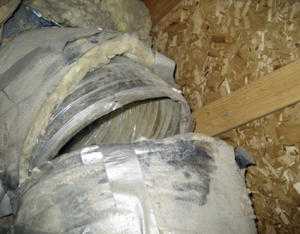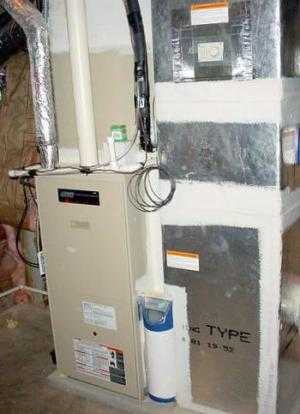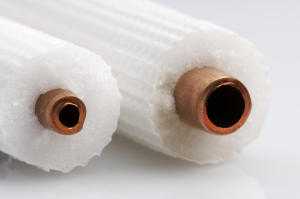Following up on my last blog post in which I covered some of the non-energy benefits of complying with up-to-date building energy codes, in this post, I’ll highlight a few more important areas where the International Energy Conservation Code (IECC), the most widely adopted energy code for residential construction, aligns with other building safety and health requirements and how it can help builders cut down on callbacks and increase performance.
Specifically, I’ll dive into mechanical and water heating systems—supply and return duct systems, cooling systems, and hot water piping insulation. Failure to comply with the mechanical system provisions in the IECC can lead to several unintended consequences that negatively affect more than just energy consumption—including indoor air quality, premature equipment failure, and a less-controllable and less-comfortable environment for homeowners and tenants.
Issue 1: Leaky duct systems
 Air leaks in supply and return duct systems not only cause significant energy waste, they may also lead to backdrafting of combustion appliances, which can have a detrimental effect on the air quality within a building. Backdrafting becomes a potentially dangerous issue when gas furnaces are located in a conditioned space (e.g. the basement) next to other gas appliances such as water heaters.
Air leaks in supply and return duct systems not only cause significant energy waste, they may also lead to backdrafting of combustion appliances, which can have a detrimental effect on the air quality within a building. Backdrafting becomes a potentially dangerous issue when gas furnaces are located in a conditioned space (e.g. the basement) next to other gas appliances such as water heaters.
Leaky ducts create problems with backdrafting and lead to heat loss. (Photo: Ryan Meres)
If supply ductwork connected to the furnace is located in a vented attic and is very leaky, there may not be adequate air available to return to the furnace. In attempting to “find” an adequate amount of air to return to the furnace, the ductwork will pull in air through leaks in the building envelope and will potentially pull in air through the water heater vent, causing the water heater to backdraft. Leaky return ducts located in the basement containing a water heater can also cause backdrafting by depressurizing the space—the negative pressure (suction) can draw unwanted air down vents and flue pipes. Ductwork formed by framed cavities can also cause indoor air quality problems.
How energy code compliance helps: Many of these problems can be avoided by following the provisions of the 2015 IECC, which requires ducts, air handlers, and filter boxes to be sealed in accordance with the International Residential Code or the International Mechanical Code. Ducts are also required to be tested to have a leakage rate of less than or equal to 4 cubic feet per minute per 100 square feet of conditioned floor area. The code also disallows building cavities to be used as ducts or plenums.
Builders should also consider other strategies to meet the duct sealing and testing requirements. One potential strategy is to bring the ductwork and air handler inside the building’s thermal envelope because doing so eliminates the requirement to test the ducts. One common strategy for bringing duct work inside the building’s thermal envelope is to use spray foam insulation on the roofline instead of using blown-in insulation on the ceiling joists. Alternatively, where the air handler and duct work is located in the basement, the walls can be insulated instead of the floor joists to eliminate the requirement to test the ducts.
When locating combustion appliances inside the building thermal envelope, builders must use high-efficient (direct vent) furnaces and hot water heaters to avoid the requirement in the 2015 IECC to enclose the appliances in a combustion closet. By using the new Energy Rating Index (ERI) compliance path in the 2015 IECC, builders can also get credit for installing high-efficient appliances.
Complying with energy codes by ensuring that all ducts are sealed, ducts located outside of the conditioned space are tested, and the use of framed cavities as ductwork is prohibited will significantly reduce the potential for backdrafting and moisture issues such as mold, and will help prevent degradation of insulation, contaminants leaking into conditioned space, and rotting of structural members.
 Issue 2: Cooling system sizing for humid climates
Issue 2: Cooling system sizing for humid climates
Oversized cooling systems in humid climates can lead to premature wear on cooling systems and humidity issues in residential construction that can affect the health of occupants in the form of allergic symptoms and respiratory discomfort as well as promote the growth of bacteria, viruses, and mold. Oversized systems cycle on and off more than “right-sized” cooling systems, reducing the effectiveness of dehumidifying the air. Proper dehumidification requires a higher percentage of run time, during which the coil is operating at its coldest temperature and allowing more condensation to form and flow out of the system. More starts and stops accelerate wear and tear on the equipment, which can lead to premature failure.
A high-efficiency furnace that’s not too big or too small helps regulate indoor humidity levels. (Above Photo: DOE)
How energy code compliance helps: Energy codes require that an Air Conditioning Contractors of America (ACCA) Manual J heating and cooling load calculation be conducted to size the cooling system. In addition, the energy code requires that cooling equipment be selected based on the methodology described in ACCA Manual S. Properly sizing the systems may lead to a reduction in humidity issues and longer life for the cooling system, cutting homeowner costs and potential callbacks.
 Issue 3: Hot water piping insulation
Issue 3: Hot water piping insulation
Leaving hot water piping uninsulated can lead to a significant increase in residential water usage in addition to an increase in energy usage. As hot water sits in a plumbing line between uses, the water cools to a temperature that is not desirable for the homeowner. The hot water faucet is typically turned on and left to run in order to get Insulated hot water pipes save energy and water. (Photo: Shutterstock by pedrosala)
water to the desired temperature for washing hands and taking showers—sometimes for as long as a few minutes—which wastes a large amount water. If the pipe has multiple hot water draws within a period of 10–60 minutes, as may happen in a kitchen, the amount of water that can be wasted is extraordinarily high.
How energy code compliance helps: The IECC requires that most hot water piping be insulated to not only save energy but to also reduce water use in the house. Insulation improves performance during all three phases: delivery, use, and between uses. Compliance with the piping insulation requirements of the energy code also helps to prevent pipes from freezing. Although it may be hard to sell most prospective home buyers on the benefits of reducing water as a societal benefit (i.e., California’s current drought restrictions) it shouldn’t be hard to get them to understand the benefit of not having to wait minutes to get hot water to wash their hands or dishes or take a shower.
Note: There are many good strategies for not only reducing energy and water consumption associated with hot water use, but also ways to reduce material and labor costs for installation. Gary Klein, one of the world’s leading experts on hot water systems, provides an excellent write-up on smart, effective design strategies.
As most building professionals will tell you, with any code, workmanship and attention to detail are necessary to ensure that efficiency features are installed properly to receive the true benefit of code requirements. This type of due diligence in complying with modern energy codes helps cut utility bills, increase durability of the envelope, improve air quality, and provide a more controllable and comfortable environment for occupants. To read more about the non-energy benefits of code compliance, download IMT’s report, Building Energy Codes: Creating Safe, Resilient, and Energy-Efficient Homes and other free code compliance resources on IMT’s website.
This blog post also appears in Builder Magazine.